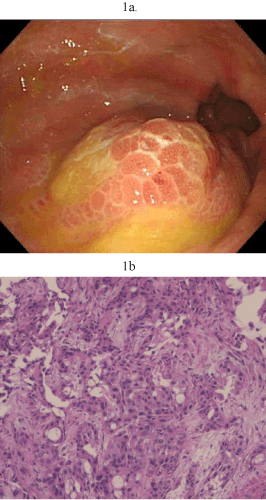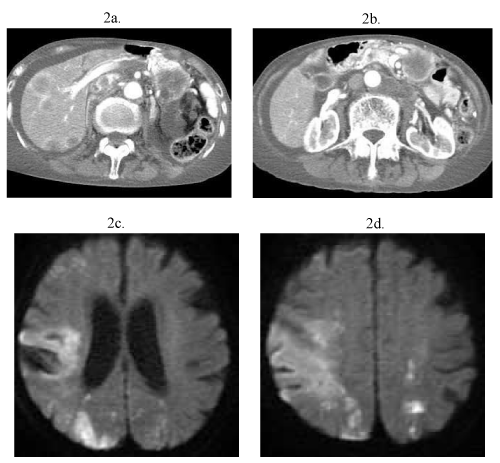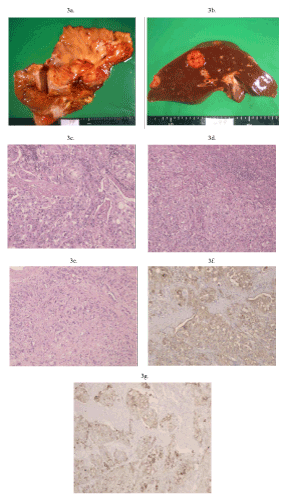|
|
| Nobuhiro Takeuchi1*, Shuho Semba2, Kazuyoshi Naba3, Tetsuo Maeda1, Hidetoshi Tada1, Ryota Aoki1, Yu Nishida1 and Yusuke Nomura1 |
| 1Department of Gastroenterology, Kawasaki Hospital, Kobe, Japan |
| 2Division of Pathology, Department of Pathology, Kobe University Graduate School of Medicine, Kobe, Japan |
| 3Department of Laboratory Medicine, Kawasaki Hospital, Kobe, Japan |
| *Corresponding author: |
Nobuhiro Takeuchi
Department of Gastroenterology
Kawasaki Hospital
3-3-1 Higashiyama-cho
Kobe, Hyogo 652-0042, Japan
Tel: +81-78-511-3131
Fax: +81-78-511-3138
E-mail: takeuchi_nobuhiro@kawasaki-hospital-kobe.or.jp |
|
| Â |
| Received December 05, 2012; Published January 07, 2013 |
| Â |
| Citation: Takeuchi N, Semba S, Naba K, Maeda T, Tada H, et al. (2013) A Female Presenting with Trousseau Syndrome in End-stage Pancreatic Cancer: A Case Report. 2:594 doi:10.4172/scientificreports.594 |
| Â |
| Copyright: © 2013 Takeuchi N, et al. This is an open-access article distributed under the terms of the Creative Commons Attribution License, which permits unrestricted use, distribution, and reproduction in any medium, provided the original author and source are credited. |
| Â |
| Abstract |
| Â |
| An 84-year-old female with a history of gastric and gingival cancer was admitted to our hospital with complaints of appetite loss and bilateral leg edema. With a body mass index of 13.7, the patient appeared to be extremely emaciated. An upper gastroendoscopy revealed a reddish, cobblestone-like mass at the greater curvature of the stomach, suggesting recurrent gastric cancer. Contrast-enhanced abdominal computed tomography revealed a pancreatic tumor with multiple metastases in the liver and para-aortic lymph nodes. Stage IVb pancreatic cancer with recurrent gastric cancer was suggested. The patient was provided with best supportive therapy. An acute cerebral infarction occurred on day 13. Although the patient was treated with heparin sodium, edaravone, and glycerol, she died of respiratory failure on day 16. An autopsy, performed with consent of her family, revealed that the gastric tumor was due to an invasive pancreatic tumor. Immunostaining analysis confirmed that the gastric tumor was compatible with invasion by the pancreatic tumor. Trousseau syndrome is characterized by thrombosis occurring in a patient with a malignant tumor. We encountered a case of Trousseau syndrome in a female patient with end-stage pancreatic cancer. Moreover, in this case, immunostaining was effective to confirm that the stomach tumor was due to invasive pancreatic cancer. |
| Â |
| Introduction |
| Â |
| A case of thrombosis associated with a malignant tumor was first reported by Trousseau in 1865 [1], which supposedly resulted from chronic disseminated intravenous coagulation. Later, malignant tumors were found to occasionally accompany arterial or venous thrombosis, pulmonary embolisms, or non-infectious endocarditis [2,3]. Trousseau syndrome is associated with poor prognosis due to coagulation abnormalities of malignant tumors [4]. Although 90% progressive malignant tumors with metastases have coagulation abnormalities [5], 50% result in thrombosis or embolism. In our case, although a stomach tumor revealed via upper gastroendoscopy was originally believed to be a recurrence of gastric cancer, immunostaining showed that such growth was due to invasive pancreatic cancer. However, there are few reports mentioning endoscopic findings of stomach tumors resulting from invasive pancreatic cancer because pancreatic cancer rarely invades the stomach. Thus, our case is very unique. Herein, we report a case of Trousseau syndrome in a female patient with end-stage pancreatic cancer. |
| Â |
| Case Presentation |
| Â |
| An 84-year-old female with a history of gastric cancer (treated with distal gastrectomy and Billroth-I reconstruction) at the age of 67 and gingival cancer (treated by tumor resection and pedicled pectoralis major muscle flap reconstruction) at the age of 81, was admitted to our hospital with complaints of appetite loss and bilateral leg edema. The patient had no history of alcohol consumption or smoking and could not take in any food; hence; she lost 10 kg within 1 month. An initial clinical examination revealed a body mass of 32.0 kg, height of 153.0 cm, body mass index of 13.7, and an extremely emaciated appearance. The performance status of the patient was poor and she had obvious bilateral pitting edema of her legs. A weakened respiratory sound was heard in the bilateral lower lungs, but her heart sounds were normal. Blood chemistry analysis revealed mild anaemia (red blood cell count, 332 × 104/μl; haemoglobin, 11.2 g/dl), mild hypoproteinemia (5.4 g/dl), mild hypoalbuminemia (2.7 g/dl), slightly elevated lactate dehydrogenase level (293 IU/l), elevated C-reactive protein level (5.0 mg/dl), and coagulation dysfunction (prothrombin time, 74%; activated partial thromboplastin time, 26.9s; fibrin/fibrinogen degradation products, 38.9 μg/ml; and D-dimer, 25.2 μg/ml). Tumor marker analysis revealed an elevated carcinoembryonic antigen level (50.6 ng/ml), slightly elevated squamous cell carcinoma antigen level (7.2 ng/ml), and a carbohydrate antigen 19-9 level within normal limits (12.4 U/ml). Electrocardiography revealed normal sinus rhythm and a heart rate of 68 beats/min. Chest radiograph revealed no cardiomegaly with a cardiothoracic ratio of 48.1% and bilateral pleural effusions. Echocardiogram revealed no asynergy with a normal ejection fraction of 67.8%. No mitral or aortic regurgitation was evident. Moreover, no thrombus was evident in the patient’s atrial and ventricular chambers. No mass was found in the pelvis and no deep vein thrombosis was found in the lower legs. An upper gastroendoscopy revealed a reddish, cobblestone-like mass compressed by an external agent at the greater curvature of the middle body of the stomach (Figure 1a). Microscopic specimens obtained from a biopsy revealed moderately differentiated tubular adenocarcinoma with invasive proliferation (Figure 1b). Contrast-enhanced abdominal computed tomography revealed a mass with poor enhancement with contrast medium at the pancreatic body and tail, multiple liver metastases, swollen para-aortic lymph nodes, and retention of ascites (Figures 2a and 2b). Stage IVb pancreatic cancer with recurrent gastric cancer was suggested. The patient was provided with best supportive therapy. On post-admission day 13, the patient experienced impairment of consciousness and total paralysis of her upper and lower left limbs. Magnetic resonance imaging of the brain revealed high intensity signal lesions in the right parietal, posterior, and left posterior lobes (Figures 2c and 2d). A diagnosis of acute cerebral infarction was made and the administration of heparin sodium, edaravone, and glycerol was initiated; however, she died from respiratory failure on day 16. An autopsy was performed with the consent of the patient’s family. A whitish pancreatic tumor, invading into the retroperitoneal lymph nodes surrounding the pancreas and deep into the stomach walls, was found adjacent to the lateral side of the great curvature of the remaining stomach. There was a succession between the pancreatic and stomach tumors. Multiple metastases were found in the patient’s liver (Figures 3a and 3b). Cerebral infarction was found in the left parietal and bilateral posterior lobes, and bilateral basal ganglia. The cerebral artery contained no occlusion, although the basilar artery was moderately atherosclerotic. Pathological findings of the stomach and pancreatic tumors, and liver metastases revealed adenocarcinoma with similar histological characteristics (Figures 3c-3e). Immunostaining examinations of the stomach tumor by carbohydrate antigen 19-9 and Cytokeratin (CK) 7 were positive, but negative for CK 20 (Figures 3f and 3g). Therefore, the stomach tumor was indicated as an invasion by the pancreatic carcinoma. |
| Â |
|
|
Figure 1a,b: a. An upper gastroenteroscopy revealed distal gastrectomy (Billroth-I reconstruction) and a reddish, cobblestone-like tumor decompressed externally at the great curvature of the middle body of the stomach.
b. Microscopic specimens of the stomach tumor revealed a moderately differentiated adenocarcinoma with invasive proliferation. |
|
| Â |
|
|
Figure 2(a,b,c,d): a. Contrast-enhanced computed tomography revealed a tumor at the pancreatic body and tail. Multiple metastases were found in the liver. Swollen para-aortic lymph nodes and retention of ascites is indicated.
b. Contrast-enhanced computed tomography revealed a tumor at the pancreatic body and tail. Multiple metastases were found in the liver. Swollen para-aortic lymph nodes and retention of ascites is indicated.
c. Magnetic resonance imaging of the brain revealed high intensity signal lesions in the right parietal, posterior, and left posterior lobes
d. Magnetic resonance imaging of the brain revealed high intensity signal lesions in the right parietal, posterior, and left posterior lobes. |
|
| Â |
|
|
Figure 3: a. Macroscopic specimens of the stomach tumor.
b. Macroscopic specimens of the liver metastases.
c. Microscopic specimens of the stomach tumor.
d. Microscopic specimens of the liver metastases.
e. Microscopic specimens of the pancreatic tumor (hematoxylin and eosin staining), which were histologically similar adenocarcinomas.
f. Immunostaining analysis of the stomach tumor by CA 19-9.
g. Immunostaining analysis of the stomach tumor by CK-7. Cancer cells, stained using CA 19-9 and CK 7, confirmed that the stomach tumor was an invasion of pancreatic cancer. |
|
| Â |
| Discussion |
| Â |
| Trousseau syndrome is a paraneoplastic neurological syndrome characterized by a malignant tumor. In 1865, Trousseau reported a case of gastric cancer with multiple venous thrombosis with concurrent cerebral and pulmonary infarctions [1]. Later, thrombosis associated with malignant tumors became known as Trousseau syndrome. In brain tissue, thromboplastin, which triggers the extrinsic clotting system, is abundant, whereas thrombomodulin, which is an adhesion molecule, is scarce; therefore, the brain is susceptible to disseminated intravascular coagulation. |
| Â |
| Malignant tumors with concurrent thrombosis are characteristic of pancreatic, lung, and ovarian cancers. Sack et al. [6] reported that pancreatic cancer is the most common cause of Trousseau syndrome, accounting for 40% cases, whereas Cestari et al. [7] found that lung cancer was the causative factor of 30% cases. Trousseau syndrome is histologically observed in adenocarcinomas and, especially, in mucin-producing adenocarcinomas [8]. Changes in the saccharide content, including mucin, on the cell surface was associated with adhesiveness and coagulation abnormalities [9]. |
| Â |
| Trousseau syndrome involves coagulation activation by the tumor and has some association with mucin content. Tumors produce mucin, which circulates and stimulates platelet aggregation in response to P- selectin in leukocytes and L- selectin in thrombocytes, without producing thrombin [9]. Heparin inhibits platelet aggregation by inhibiting the ligand of selectin and binding of mucin and selectin [9]. Therefore, heparin is effective for the prevention of thrombi associated with malignant tumors, unlike warfarin. Although Green and Walsh-McMonagl [10] reported that heparin administration improved survival rate, the prognosis of Trousseau syndrome is generally poor. The average survival time of Trousseau syndrome patients after cerebral infarction is reportedly 4.5 months [7]. There were several risk factors for thrombosis in the present case, including advanced age and poor performance status. Moreover, lower leg edema due to hypoproteinemia probably affected thrombus formation. Therefore, as soon as the diagnosis of progressive pancreatic cancer was made, we should have taken some preventive measures against thrombosis such as heparin administration or the use of elastic compression stockings or an intermittent pneumatic compression device. |
| Â |
| Pancreatic cancer is rarely diagnosed in early stages and difficult to treat. Most pancreatic cancers are histologically invasive ductal carcinomas that invade surrounding tissues. Most cases are identified in the progressive stage; therefore, the prognosis of pancreatic cancer is extremely poor. Clinical signs and symptoms of pancreatic cancer are jaundice, abdominal pain, back pain, and weight loss. Pancreatic head cancer tends to present some clinical signs in its early stage, whereas pancreatic body and tail cancers fail to present early clinical symptoms until they reach a progressive stage. Therefore, most pancreatic body and tail cancers are not diagnosed until the end-stage of the disease. |
| Â |
| In the present case, it was unclear whether the stomach tumor was due to a recurrence of gastric cancer or an invasive pancreatic cancer. Immunostaining analysis showed that the stomach tumor was not a recurrence, but rather an invasion. Pancreatic cancer sometimes invades the spleen or left adrenal gland, but rarely invades the stomach. There are few reports on endoscopic findings of stomach invasion from pancreatic cancer. |
| Â |
| Conclusion |
| Â |
| We encountered an 84-year-old female with cerebral infarction during the course of best supportive care of end-stage pancreatic cancer. Acute cerebral infarction was suggested to be associated with coagulant abnormalities of pancreatic cancer and compatible with Trousseau syndrome. Hence, attention should be paid to the probability of thrombosis when a progressive malignant tumor is encountered. Moreover, in our case, the stomach tumor was a matter of discussion as to whether it was a recurrence of gastric cancer or an invasion of pancreatic cancer. Immunostaining was effective for identifying the origin of the tumor. |
| Â |
| |
| References |
| Â |
- Trousseau A (1865) Phlegmasia alba dolens: Clinique medicule de lÂ’Hotel-Dieu de Paris. London. New Sydenham Society.
- Glass JP (1993) The diagnosis and treatment of stroke in a patient with cancer: nonbacterial thrombotic endocarditis (NBTE): a case report and review. Clin Neurol Neurosurg 95: 315-318.
- Evans TR, Mansi JL, Bevan DH (1996) Trousseau's syndrome in association with ovarian carcinoma. Cancer 77: 2544-2549.
- Varki A (2007) Trousseau's syndrome: multiple definitions and multiple mechanisms. Blood 110: 1723-1729.
- Milsom C, Yu J, May L, Meehan B, Magnus N, et al. (2007) The role of tumor-and host-related tissue factor pools in oncogene-driven tumor progression. Thromb Res 120: S82-91.
- Sack GH Jr, Levin J, Bell WR (1977) Trousseau's syndrome and other manifestations of chronic disseminated coagulopathy in patients with neoplasms: clinical, pathophysiologic, and therapeutic features. Medicine (Baltimore) 56: 1-37.
- Cestari DM, Weine DM, Panageas KS, Segal AZ, DeAngelis LM (2004) Stroke in patients with cancer: incidence and etiology. Neurology 62: 2025-2030.
- Sutherland DE, Weitz IC, Liebman HA (2003) Thromboembolic complications of cancer: epidemiology, pathogenesis, diagnosis, and treatment. Am J Hematol 72: 43-52.
- Wahrenbrock M, Borsig L, Le D, Varki N, Varki A (2003) Selectin-mucin interactions as a probable molecular explanation for the association of Trousseau syndrome with mucinous adenocarcinomas. J Clin Invest 112: 853-862.
- Walsh-McMonagle D, Green D (1997) Low-molecular-weight heparin in the management of Trousseau's syndrome. Cancer 80: 649-655.
|
| Â |
| Â |



